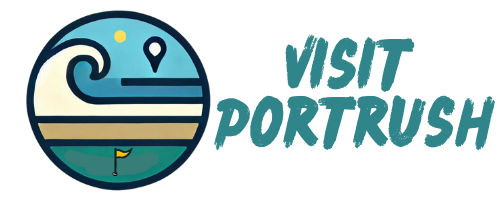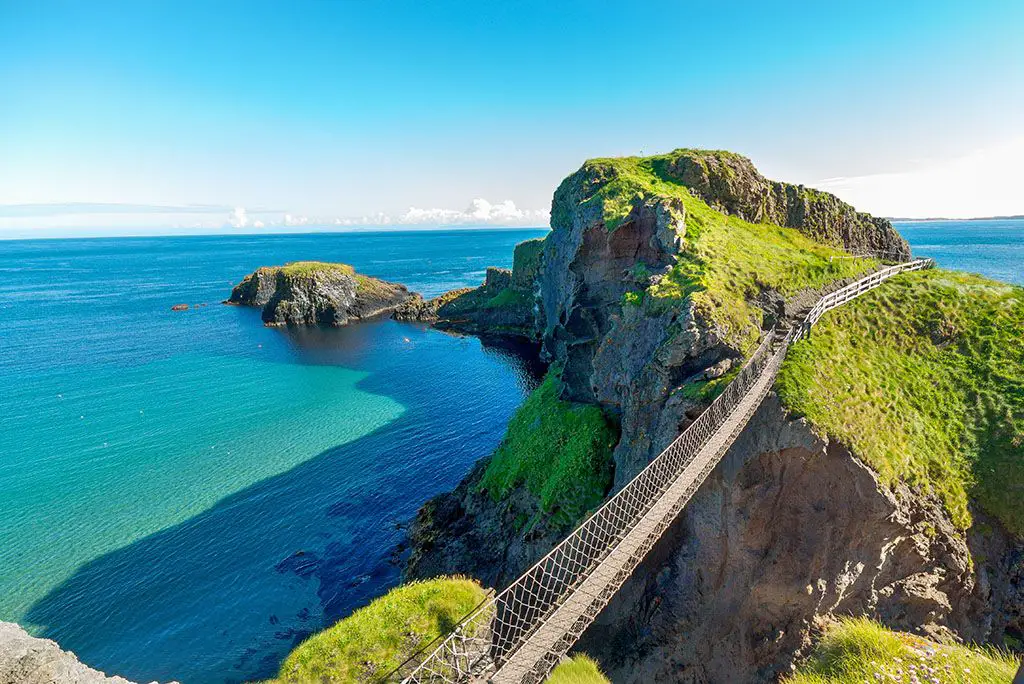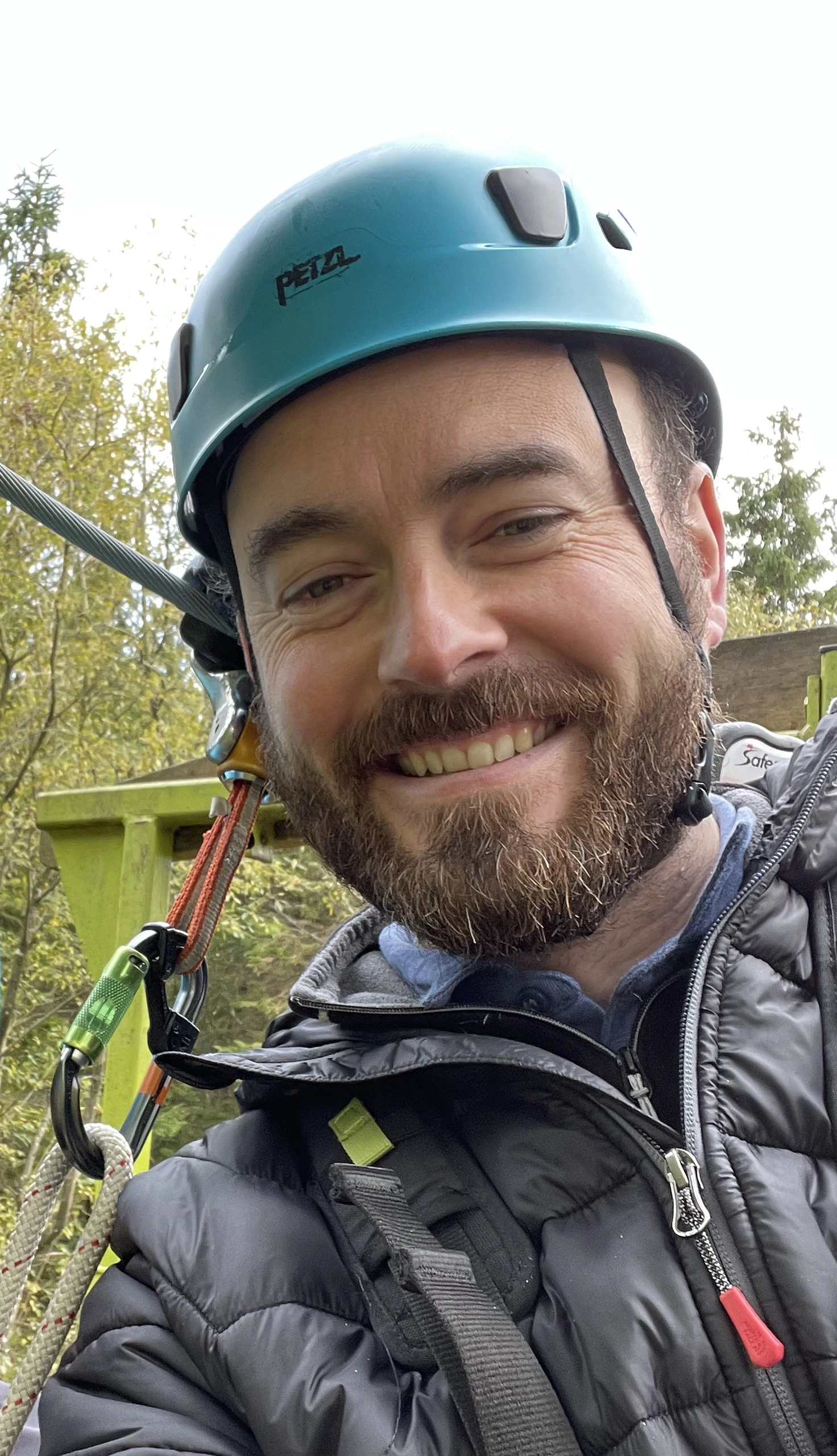Introduction to Carrick A Rede
Perched along the dramatic coastline of County Antrim, Northern Ireland, the Carrick-a-Rede rope bridge is one of the region’s most exhilarating attractions. Suspended nearly 100 feet above the wild Atlantic Ocean, this rede rope bridge links the mainland to the small island of Carrick-a-Rede, inviting visitors to cross into a world of natural beauty and unique geology. As you step onto the bridge, you’re treated to sweeping views of rugged cliffs, turquoise waters, and the untamed north coast. Whether you’re seeking adventure or simply want to soak in the scenery, Carrick-a-Rede rope bridge is a must-visit destination for anyone exploring Northern Ireland’s iconic Causeway Coastal Route.
Carrick-A-Rede Ropebridge in County Antrim
Carrick-a-rede is a famous footbridge located near Portrush on the North Coast of Northern Ireland.
The name Carrick-a-rede is from the Irish Carraig a’ Ráid meaning “rock of the casting”.
The footbridge connects a tiny rocky island called Carrick-a-rede to the mainland, offering breathtaking views of the Atlantic Ocean, therefore, earning the name Carrick-a-rede footbridge.
Carrick a rede has had a bridge for over 350 years ago, initially built at the start of each fishing season with slates of wood strung up with just one guide rope.

No one lives on the island; however, there is a single building—a fisherman’s cottage and workshop—previously used by the local salmon fishermen who used it for shelter and to land their catch. For many years the sole function of the bridge was to transport men on and off during the salmon season, which runs from June to September, until the salmon population dwindled to a point whereby it became unviable to make a living from fishing. Sadly, 2002 was the last season that was commercially fished, where the annual catch was just over 300, which was the average catch per day in the 1960s. Now, there are very few salmon and only a handful of salmon left, highlighting the environmental impact and changes over time.
The current bridge is now owned by the National Trust and was built by Heyn Construction in 2008 at a cost of £16,000 ($21,000). The National Trust, a conservation charity, plays a crucial role in preserving and maintaining the site. Local climbers have also been involved in building and maintaining the bridge, especially during past upgrades and safety improvements. Whereas the original bridges were made of rope and wood, the current bridge is built of steel wires ropes and Douglas Fir wooden slats along the path. In terms of dimensions, the new bridge is 66 ft long and is suspended nearly 100 ft above sea level, over crashing waves and rocks. The bridge can support up to 10 tonnes of weight…..more than enough to support the 8 visitors limit that the wardens allow at any one time.
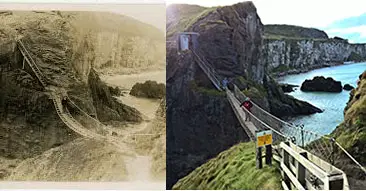
If the weather is turbulent, the gates will be closed off for safety purposes, therefore, before visiting the area check on the weather. You can also check on the dedicated Twitter (@NTCarrickarede) site for the most up to date information. Most tourists tend to avoid it during the rainy and windy days, so it may the best time to go if you want it all to yourself.
From speaking to the local guides, there have been many instances where visitors go over and they are afraid to come back across the bridge due to the wind swaying the bridge. Therefore, their only option is to be ferried back from the island to the mainland via a boat. There are the people who land on the island using helicopters, but this is a rare occurrence happening once or twice in a year.
If you want to get an alternative view of the Rope Bridge, there are sailing and kayaking tours that will take you under the bridge. When the tide is unusually low, you can even walk under the bridge.
These tours are ideal for exploring the rarely seen caves, which were made famous in the HBO series Game of Thrones. Sunset at Carrick-a-Rede Rope Bridge in County Antrim this week. Photo by Tim Johnston. pic.twitter.com/LO2t9O4Ogx— Barra Best (@barrabest) 4 May 2017
The journey to the bridge is not ideal for people with mobility issues, not because of the bridge itself, but the path leading up to the bridge is essentially an uneven gravel path…and then there are the steps at the end.
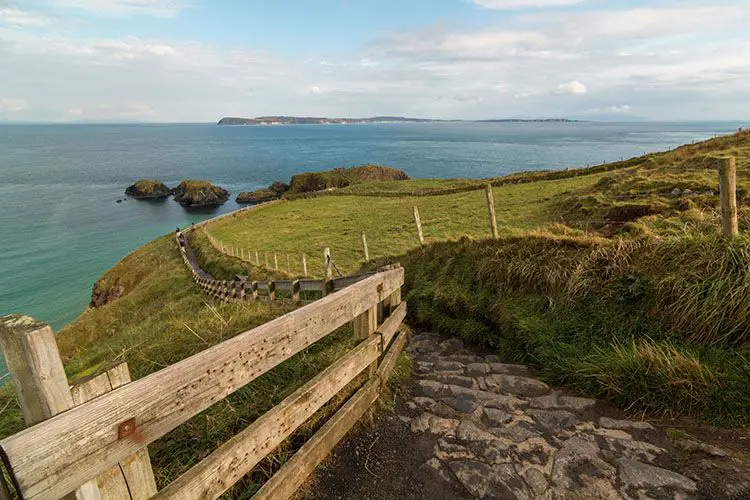
If you can master the courage to descend down the steps and walk across the bridge, which only takes a few minutes, you will be rewarded with spectacular views. The island is the final destination of the rope bridge experience. From the island, you will be able to see Rathlin island, Ireland’s only inhabited offshore Island, and even Scotland. You will also get to enjoy the flora found on the island and breathtaking views of a clear blue sea.
When you arrive in the area, there is a car park, and if you feel a bit chilly after hiking your way to and from the bridge, then there is a tea room where you can have some of the best tea in that part of Ireland.
To help spread visitor numbers and improve the experience, pre-booking tickets is encouraged, allowing for better management of foot traffic throughout the day.
History of the Rope Bridge
The story of the Carrick-a-Rede rope bridge stretches back over 350 years, rooted in the traditions of local salmon fishermen. These fishermen originally constructed simple rope bridges each season to access the rich fishing grounds around Carrick-a-Rede island. Over time, the bridge has appeared in many forms, evolving from basic wooden planks and a single rope handrail to the much safer and sturdier structure seen today. The current wire rope bridge, built by Heyn Construction in 2008, reflects centuries of innovation and adaptation, ensuring that visitors and fishermen alike could cross safely. Today, the rede rope bridge stands as a testament to the area’s fishing heritage and the enduring spirit of Carrick-a-Rede.
Features of the Rope Bridge
Crossing the Carrick-a-Rede rope bridge is an unforgettable experience, thanks to its impressive engineering and breathtaking setting. The bridge spans 66 feet in length and is suspended 100 feet above the crashing waves and rocks below, offering a thrilling yet secure passage to the island. Constructed from strong wire rope and Douglas fir, the current bridge provides a much safer passage than its predecessors, which once featured only one handrail and large gaps between the slats. Now, visitors can enjoy the exhilaration of the crossing while taking in stunning views of the Atlantic Ocean and the surrounding coastline, making the rede rope bridge a highlight for adventurers and sightseers alike.
How Much Does it Cost?
Carrick-a-rede is open all year round and is free for those who just want to walk along the coastal path see the bridge close up or, however, if you’re going to cross onto the island you’ll need to purchase a ticket.
As the bridge can get very busy at times (it had over 450000 visitors last year) the National Trust has started to operate an online timed ticketing service. Timed tickets help to spread visitor numbers throughout the day, improving the visitor experience and managing foot traffic. Visitors are able to purchase tickets from 09.30, with the latest ticket sale at 18.15 during peak season.
The cost of crossing the Carrick-a-Rede Rope Bridge in Northern Ireland depends on the type of ticket and time of year:
Ticket type | Off-peak | Peak season |
|---|---|---|
Adult | £13.50 | £15.60 |
Child (5–17) | £6.75 | £7.75 |
Family (2 adults, max 3 children) | £33.75 | £38.75 |
Family (1 adult, max 3 children) | £20.50 | £23.25 |
Some people can cross the bridge for free, including:
- National Trust members: Adults and children aged 5 and up can cross for free if they bring their membership card
- Local pass holders: Can cross for free if they bring their local pass
- Children under 5: Free of charge, but they still need a ticket
- Essential companions or carers: Free for those accompanying a disabled visitor
The bridge is closed on windy days and in bad weather. It’s recommended to pre-book tickets online to avoid queues and delays.
National Trust Members and Touring Pass holder are free…but still have to book.
You can book online here
Tours of Carrick-a-Rede
Visiting the iconic Carrick-a-Rede Rope Bridge is more than just a sightseeing experience—it’s an adventure! Several guided tours are available, offering visitors the chance to learn about the fascinating history, geology, and wildlife of this stunning location.
Booking a Tour
It’s advisable to book your Carrick-a-Rede tour in advance, especially during peak seasons. Many tours depart from popular hubs like Belfast or Portrush, offering convenient transportation options for visitors staying in those areas. Check with your chosen tour provider for details on group sizes, availability, and weather considerations.
Whether you’re a history buff, nature enthusiast, or thrill-seeker, a guided tour of Carrick-a-Rede ensures you get the most out of this unforgettable experience.
Carrick-a-Rede on Film and Tv: A Haven for Salmon Fishermen
The HBO Fantasy series based on Goerge R. R. Martins Novels, Game of Thrones, has filmed a number of their scenes on the island. Most of the scenes are in the second season.
Carrick a rede was the land referred to as Storms End located in Stormlands. The land had one of the strongest castles in the realm and was under the control of the House Baratheon. In the game of thrones, the producers made storms end the regional capital. Carrick at rede island featured in season 2 episodes below.
Episode 3: What is dead may never die – this is when Catelyn Stark arrives in Baratheon’s camp during a tournament that was won by Brienne of Tarth. Later Baratheon shows off his army of 100,000 strong men willing to fight to the death for him. You can see the Larrybane Quarry next to Carrick-a-rede and the making of that episode here
Episode 4: Garden of bones – this is when Little finger arrives at Renley Baratheon’s camp as a political envoy to try and gain his trust
- King Stannis also arrives at stormlands and heads to Renley’s Baratheon’s camp to ask Renley to relinquish his claim to the throne and serve him
- Ser Davos takes the red priestess via boat to some caves near Renleys camp where she gives birth to a shadow creature
Episode 5: The Ghost of Harrenhal – this is when Renley Baratheon is killed by the shadow creature born by the high priestess and his army divides after his death.
Geology
Carrick A Rede island is the best example of a volcanic plug in Northern Ireland. Erosion by the Irish Sea/Sea of Moyle has exposed the neck of this old volcano.
The extreme violence of the volcanic eruptions is evident in the geological features of the area. Around 60 million years ago, molten rock punched through the soft chalk, leaving behind geological evidence such as Tuff, Explosion breccias, explosion bobs and grey volcanic ash in the layers of the rock of the Island and surrounding.
Along the whole North Antrim coast, that forms much of the Antrim plateau, the characteristic Ulster Chalk is topped by basalt cliffs. At Carrickarede, the ancient volcanic pipe has left dolerite, a tougher rock than basalt, which erodes more slowly. Behind the dolerite, to the south, the vent is filled with pyroclastic rocks that break down more easily, mostly a coarse tuff agglomerate. The combination of the hard rock out front and the softer rock behind, with long-term erosion by the waves, has eventually left this small island.

The island has Large caves which can be seen best during low tide. It is assumed that at some point the caves were used to serve as boat builders homes. They also provided shelter for fishing vessels during stormy weather.
The natural sea surrounding the area has blue waters that sometimes turn green making it an area of particular interest. Unique flora and fauna cover the island. It has a lot of bird colonies that play an essential role in the area’s ecology. Example, Razorbills are birds that live the island and only come back when it is time to mate and nest. The cliffs of the island are covered with birdsfoot trefoil and thrifts that give the island a paradise-like look.
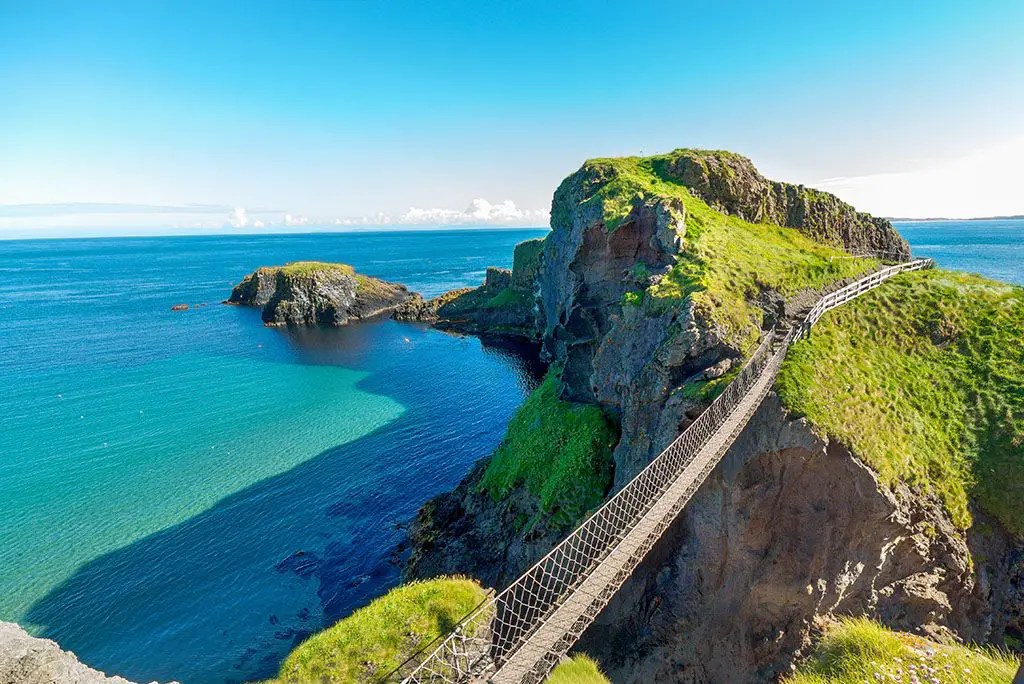
How to Get To Carrick A Rede in Northern Ireland
There are several routes you can take to get to the National Trust Carrick a rede rope bridge. It’s important to note that the bridge opens at 9:30 am, and the ticket sales stop at 5:15 in the afternoon that’s 45 minutes before the closing time. In some circumstances, the closing time may be changed due to tourist traffic. In the summer the closing time is extended to 7:00 pm because it is the peak season while in the winter the closing time can be as early as 3 in the afternoon, this can be due to the severe weather conditions or lack of tourists wanting to cross the bridge.
Carrick a rede is located only 15 miles (around 20 minutes) from Portrush and 60 miles (around an hour) to the north of Belfast. For ease, most tourists are guided to the area by a tour guide at a small fee.
Public Transport
Bus – visitors who are not familiar with the Portrush area can head out on the bus from Dunluce Avenue and take the 402(a) or 172 also known as the causeway Rambler. A timetable for this can be found here. From Belfast, visitors can take the 218 Goldline Bus (or the train as they stop in the same place) to Coleraine and then get the 402 or 172 Bus as above.

Car – Carrick-a-rede is only a short 15 mile or 20-25 minute drive along the stunning Causeway Coastal Route (A2)from Portrush, passing the Giants Causeway, The Dark Hedges and Dunluce Castle. Driving from Belfast will take around 1 hour 10 minutes depending on the traffic to cover the 60 miles. First, you will have to take the M2 route, then switch on to the A26 until Cloughmills and then switch over to the A44 (Drones road which switches onto Maghermore in Capecastle) to arrive at the park.
If you have a bit more time, then we recommend you take the Causeway Coastal Route from Belfast to Portrush. This is one of the best driving routes in the world. You can find out more about it here.
Airport
The fastest way to access Carrick-a-rede is by using one of the airports around Belfast.
Belfast International Airport (BFS) – this is an international airport approximately 20 miles away from the Belfast city centre. From the airport take the 300 Airport Express Bus to Belfast City centre, the journey takes about 40 minutes. You can also hire a taxi.
George Best Belfast City Airport (BHD) – this is situated two miles away from the Belfast city centre. It is a relatively small airport that deals with domestic flights. From the Airport take a cab to the Belfast city centre where you can choose one of the causeway rambler buses.
From Dublin
The best-known way to get to the bridge from Dublin is by driving yourself, it will take around 3 and a half hours from the city centre. If you don’t fancy driving or want to take the opportunity to see as much of the scenery as possible, then it is best to take one of the many tours that operate daily from Dublin.
You can learn more about what to visit in Northern Ireland find out more details about them here
Well, that’s it, our guide to Carrick-a-rede Ropebridge, we hope you find it useful in planning your trip. If you have already been let us know how it went and if there is anything that we have missed. We will continue to update this page as we get more information.
Nearby Attractions
Carrick-a-Rede rope bridge is perfectly positioned along the world-famous Causeway Coastal Route, making it an ideal base for exploring Northern Ireland’s north coast. Just a short drive away, you’ll find the legendary Giant’s Causeway, a UNESCO World Heritage Site renowned for its unique geology and striking basalt columns. The charming village of Ballintoy, with its picturesque harbor and local shops, offers a taste of traditional coastal life. Outdoor enthusiasts can enjoy hiking, cycling, and water sports in the surrounding area, all set against a backdrop of natural beauty and dramatic cliffs. With so much to see and do, Carrick-a-Rede is the perfect starting point for your County Antrim adventure.
Tips and Essentials
To make the most of your visit to Carrick-a-Rede rope bridge, a little planning goes a long way. Onsite car parking is available, providing easy access to the bridge and the scenic coastal path. It’s wise to book your visitor experience tickets in advance, especially during peak times, to avoid queues and guarantee your crossing. The bridge is open year round, but may close temporarily during stormy weather for safety reasons—always check ahead before you travel. The first 0.5km of the coastal path is accessible and features an accessible telescope for panoramic sea views, though assistance may be needed for the rope bridge crossing itself. With its unique geology, rich history, and spectacular scenery, Carrick-a-Rede rope bridge promises an unforgettable experience for every visitor.
